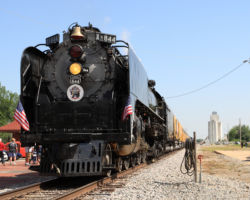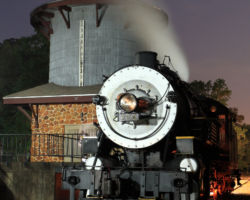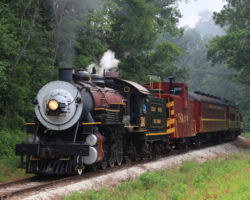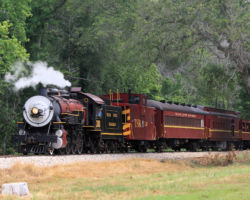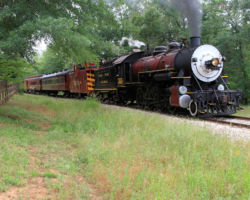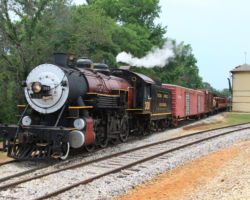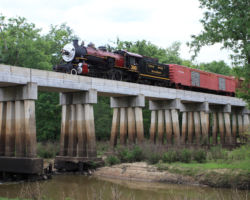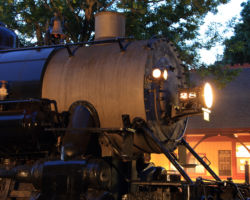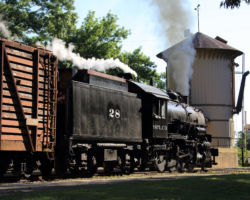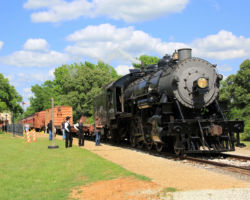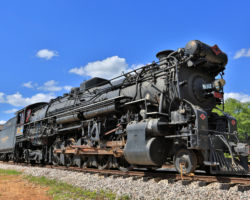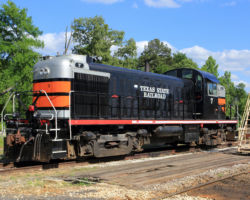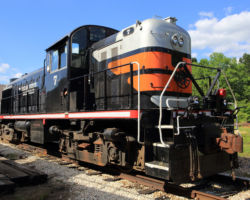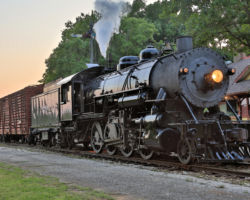History
In order to understand the railroad, let’s take a look at the line’s unique history and how it came to be the heritage railway that it is today.
The history of the line starts back in 1875, when the Texas legislature designated Rusk, TX, as the site for a new state prison. The penitentiary added a pig iron smelter and foundry in 1884, and in 1896 a short industrial railroad was constructed by the prisoners to bring fuel wood and iron ore from the west to the facility. The smelter expanded in 1903, and so did the railroad, extending another five miles to Maydelle to access more timber. In 1907, the legislature approved making a common carrier of the railroad and extending it to Palestine, where it could interchange with the International – Great Northern Railway’s mainline from Longview to Laredo (later Missouri Pacific and then today Union Pacific). This would a second connection to the outside world, which in theory would provide competition and better rates for the prison’s inbound and outbound traffic, since prior to the extension the railroad’s only interchange was with the St. Louis Southwestern’s (Cotton Belt) Tyler-Lufkin line at Rusk. The same year the Palestine extension was completed – 1909 – the Texas & New Orleans also built into Rusk with their short Gallatin Branch from near Jacksonville, TX. So now the little ~30 mile Texas State Railroad had three major interchanges.
The prison foundry closed in somewhere between 1910 and 1913, depending on sources. The original 25-ton furnace was fueled by charcoal made from timber logged along the railroad, and it wasn’t economically viable compared with the larger operations elsewhere. A second larger 50-ton coke-burning furnace was eventually added, but suffered the disadvantage of needing all fuel to be shipped in a high cost. By 1910, accounts are that the iron operation had lost some $2M, and operations were curtailed. The prison itself was closed in 1917, with the facilities reopened as a state mental hospital in 1919. The iron works was also leased out in 1919 to the Texas Steel Company, but it couldn’t make a profitable go of it either and quickly ceased operations again. (The iron works was finally demolished in 1931.)
This all left the TSR with little traffic. By 1921, the line had a debt of $366k and was headed for abandonment. The local state senator, I. D. Fairchild, convinced the legislature to allocate funds for rehabilitation and to lease out the line for operations. The Texas & New Orleans picked up the lease in November 1921, as it could feed traffic into their Gallatin Branch. (The Gallatin-Rusk branch itself was removed in 1934, when the T&NO’s parent Southern Pacific acquired control of the Cotton Belt.) The line continued to operate under lease until the formal merger of the T&NO into the Southern Pacific in 1962. At that point, SP had no interest in continuing to operate the TSR for the little traffic it provided.
Southern Pine Lumber’s (later Temple Industries’) Texas South-Eastern Railroad stepped in, leasing the line for the remainder of the 1960s as their Northern Division. As a note, the TSE had previously connected with the Texas State many years earlier. Their logging lines coming up the Neches from Diboll through Fastrill connected on the east side of the TSR’s Neches River bridge. Southern Pine Lumber owned timber lands on both sides of the river, and would operate over the TSR to reach to the mill in Maydelle. This connection was abandoned in 1946, long before the 1962 lease of the TSR.
With the termination of TSE’s lease at the end of 1969, the TSR again found itself with no operator and little online traffic. In 1972, the legislature handed the railroad to the Texas Parks and Wildlife Department with the idea of turning it into a hiking trail. Through some prodding, however, the TPWD was convinced to rehabilitate the line and turn it into a heritage railway and tourist attraction. The Parks Department continued to operate the line until 2007, when it was transferred to the Texas State Railroad Authority, and operations were contracted to American Heritage Railways (the parent company of the Durango & Silverton). AHR bowed out of the contract in August 2012, and shortly afterwards Iowa Pacific Holdings was selected as the new operator. IPH lasted until 2017, when the Authority revoked their lease over unpaid taxes. The Western Group of Utah – owners of the Cimarron Valley, the Southwestern Railroad, the Washington Eastern Railroad, Verde Canyon Railroad, and others – assumed operations as of March 2017 and continues to operate the line as of writing this.
For those interested in visiting the TSRR for themselves, be sure to see the railroad’s website for details.
To get your bearings along the line, here’s a map produced by the Texas Parks and Wildlife Department back in 2004:
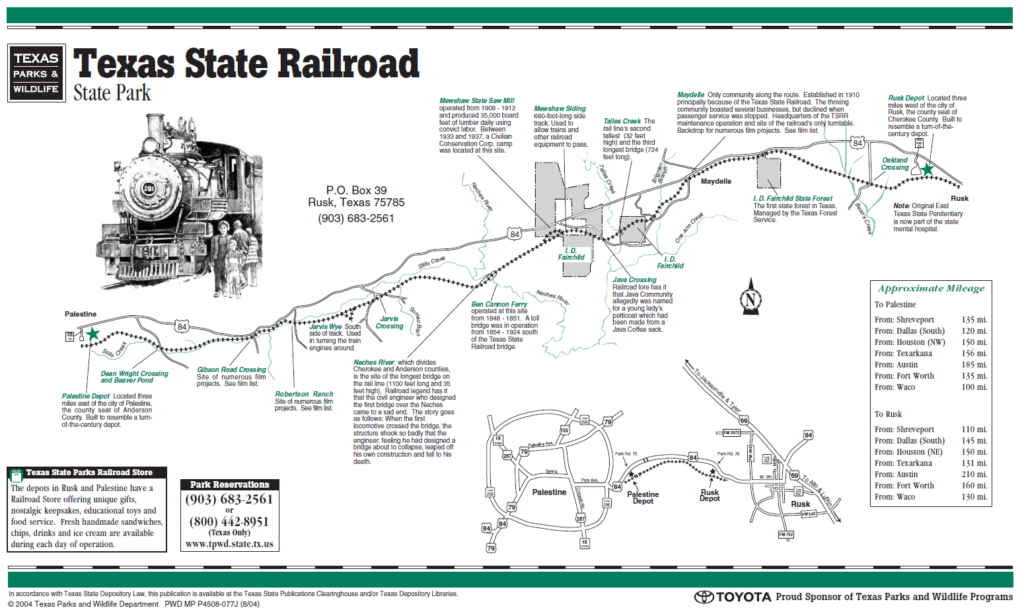
First Visit – May 5-6, 2012
Near the end of American Heritage Railways’ operation of the line in 2012, they announced a photo special during their Railfest event. I’d never visited the Texas State Railroad before, being somewhat out of the way between my home in Colorado and literally anywhere I went on a frequent basis, but I found myself working in Dallas the week before. With the TSR’s future somewhat uncertain at the time, I decided to take a couple extra days and avail myself of the opportunity to photograph something different.
A night photo session was held at the Rusk terminal on the 4th, followed by our photo special operating from Rusk to Palestine and back on Saturday.
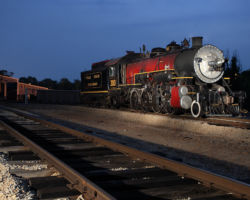
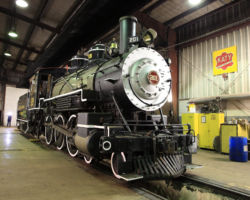
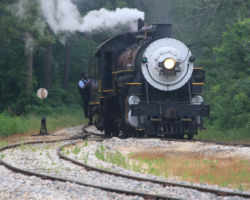
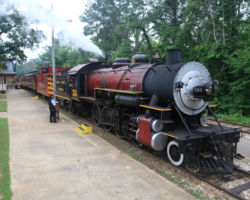
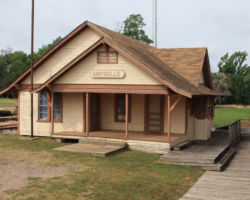
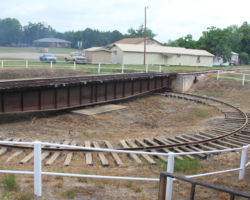
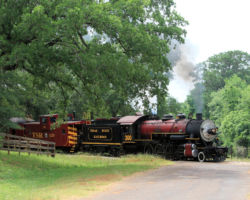
Second Visit – May 1-2, 2015
In the early months of 2015, word came through the narrow gauge grapevine that IPH was putting together a photo special on the Texas State for early May. The biggest selling point to me was the fact that engine 300 had been returned to proper, authentic Southern Pine Lumber #28 paint rather than wearing that garish red with yellow trim from the Parks Department and American Heritage Railways eras of operation.
Unfortunately this time I couldn’t find a way to make a work trip out of this one, but no matter. I drove down Thursday and Friday, and made a very long haul back on Sunday.
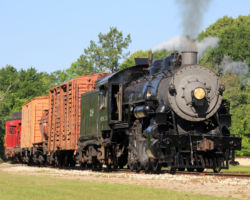
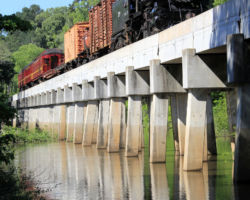
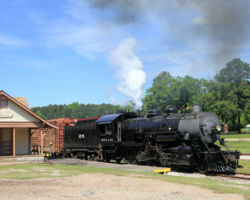
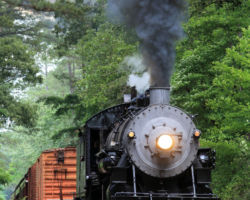
This work is copyright 2024 by Nathan D. Holmes, but all text and images are licensed and reusable under a Creative Commons Attribution-NonCommercial-ShareAlike license. Basically you’re welcome to use any of this as long as it’s not for commercial purposes, you credit me as the source, and you share any derivative works under the same license. I’d encourage others to consider similar licenses for their works.
